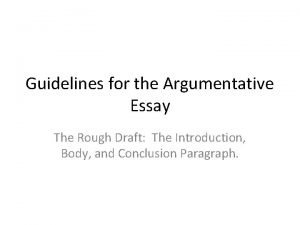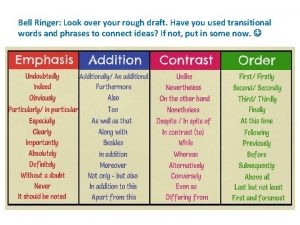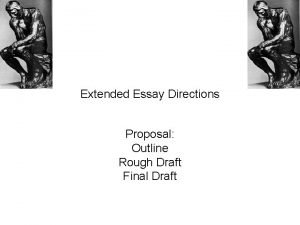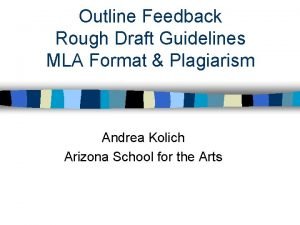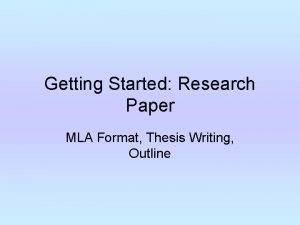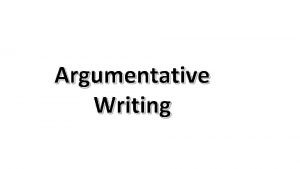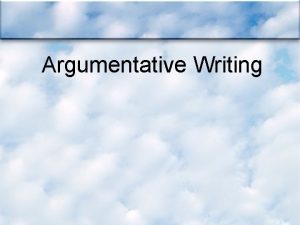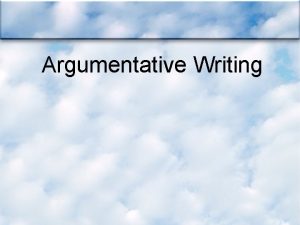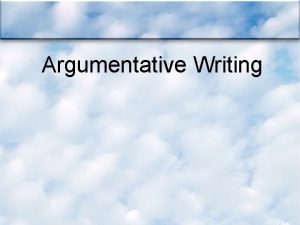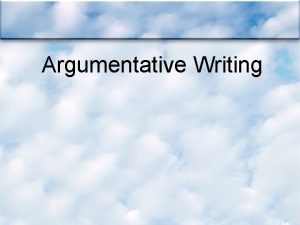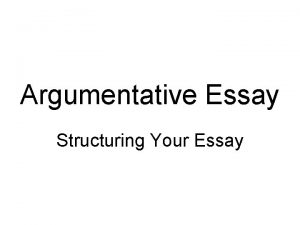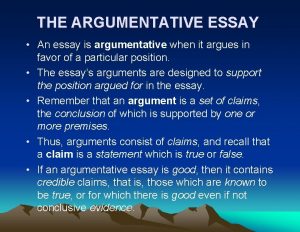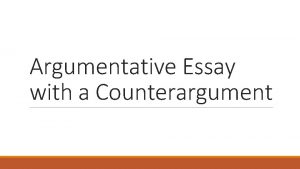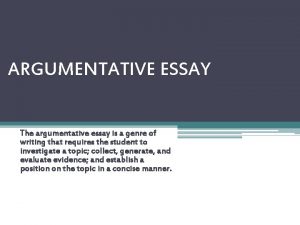Guidelines for the Argumentative Essay The Rough Draft












- Slides: 12

Guidelines for the Argumentative Essay The Rough Draft: The Introduction, Body, and Conclusion Paragraph.

Parts of the 5 Paragraph Essay I. Introduction Paragraph I. Thesis Statement including 3 Reasons. II. The Body I. Constructing Topic Sentences. II. 3 paragraphs supporting each of the reasons in the Thesis Statement. III. Countering the Opposition III. The Conclusion Paragraph

Introduction Paragraph • The Introduction tries to familiarize the reader with the topic and the purpose of the essay. • The Introduction offers a plan for the ensuing argument: – Introduction (Thesis Statement): “Tell them what you will prove. ” – Body: “Prove to them. ” – Conclusion: “Tell them what you have proved. ”

Ways to Construct the Introduction Paragraph: • Personal anecdote (a short, amusing, and/or interesting story about a real incident or person). • Using Examples (real or hypothetical). • Using Questions (Rhetorical). • Using Quotations. • Using shocking Statistics. • Using striking Images ( described through your writing).

The Thesis Statement • The thesis statement is the LAST SENTENCE in the Introduction Paragraph. • The thesis statement is the most important sentence in the essay. • It lets the reader know your answer to the question AND the 3 reasons why? • The thesis statement is NOT a factual statement, however it’s a claim that MUST be proven throughout the essay.

The Body Paragraphs (3) • Suggestions for the order of the paragraphs in the body: – General to Specific. – Most Important to Least Important. – Weakest Claim to Strongest Claim. – Etc.

The Body Paragraphs (3) • When supporting each reason, think of each paragraph as a PERSUASIVE PARAGRAPH – persuade and prove to the reader that with that reason, that is why your monarch made the biggest impact. • Use information from resources (not from your own perspective). – Quotes, Testimony, and statistics ( numbers and %).

The Opposing Argument • Addressing the claims of the “opposition” is an important part of the argumentative essay. • It demonstrates your “credibility” as a writer as you have researched multiple sides of the argument and have come to an informed decision.

The Opposing Argument • “Counterarguments” can be inputted in multiple locations in the body paragraph. • “Counterarguments” should be offered ONLY AFTER you have supported your reasons (affirmatives) with details. • Build each of your main points as a contrast to oppositional claims.

What a Counterclaim should NOT be: • Using rude or depreciating language can cause your audience to reject your position. • Remain tactful, but not disrespectful.

The Conclusion Paragraph • The Conclusion Paragraph REEMPHASIZES the main points made in the essay. • Remember, this paragraph is when you tell the reader how you prove you thesis to be correct. • You may speculate and foresee the future as a result of claim ( positive or negative). • Avoid raising new claims in the conclusion. • The essay has to have an “ending. ”

 Rough draft argumentative essay
Rough draft argumentative essay Objects of draw frame
Objects of draw frame Rough draft organizer
Rough draft organizer Counterclaim sentence starters
Counterclaim sentence starters Sports rough draft
Sports rough draft Extended essay first draft
Extended essay first draft Mla format rough draft
Mla format rough draft Mla thesis example
Mla thesis example Purpose of writing a research paper
Purpose of writing a research paper Research paper rough draft example
Research paper rough draft example Argumentative writing vs persuasive writing
Argumentative writing vs persuasive writing Expository vs argumentative essay
Expository vs argumentative essay Opinion essay vs argumentative essay
Opinion essay vs argumentative essay
